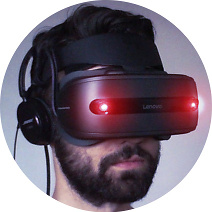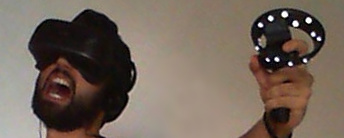Windows Mixed Reality
As the Virtual Reality scene continues to improve, the aging first-gen conceptual headsets are becoming less expensive. The HTC Vive initially retailed at CAD $1200, and now sells for $700, whereas the Oculus Rift dropped from $800 for the standalone headset to $530 including motion controllers. Windows Mixed Reality headsets are the consumer offspring of all the R&D that occurred for the HoloLens, namely inside-out tracking, and positioned themselves as the budget alternative to these premium headsets. I purchased a Lenovo Explorer on sale for $300, less than half the cost of either premium HMD; these are my thoughts on the headset and platform.
Update 2018-12-14: I’ve decided to finally finish and post this article, because Dell WMR headsets are currently on sale for $250 CAD from Microsoft, and the Oculus Rift is discounted to $450 on Amazon. I think this is a fantastic chance to jump into VR, provided you have a capable system:

Table of Contents
- Disclaimers
- Lenovo Explorer First Impressions
- Games & Compatibility
- The Headset
- Controllers
- Tracking
- Five Months Later
Disclaimers
- I already own a fairly powerful PC, packing an i7-4790k, GTX 980ti and 32 Gigs of DDR3. The cost of VR is far higher if you do not already have a powerful desktop system, (I’m fairly certain mobile CPUs can’t push 90 hertz,) you’ll have to make an investment of ~$2000 CAD or more.
- VR is NOT for everyone. at this early stage, you’ll need to have a fair bit of patience and high tolerance for unnatural movement; players can easily get motion sickness or eye problems. If you can tolerate reading in the car or working on the bus, you ought to be fine. Interpupillary distance is another common problem, especially with Windows Mixed Reality headsets which have a fixed IPD. If your eyes are significantly further apart then the 90%s ~62.8mm, do some research to find out if your face is compatible with any of the available headsets.

Lenovo Explorer First Impressions
Lenovo’s HMD arrived in a clean, well-padded box. While nowhere near the premium, luxurious packaging and thoughtful presentation of the Oculus rift, which I have also helped to unbox (and will be comparing to throughout this review,) the HMD and controllers were well-protected and easy to unpack.
The controllers eat batteries, which isn’t all that surprising when you note the thirty-two LEDs used to track the wands, while also considering the constant transmission of sensor data. The wands work fairly well, though are a far cry from the hand-fitting, effortless controllers of the Oculus Rift. What matters is that the wands track accurately (as long as they are in front of the visor,) and won’t frustrate you in the middle of an intense situation.
Right off the bat, the setup process was easy; much easier than the Oculus. To set up room-scale VR, you simply walk your headset around the room to establish your boundaries, and can begin. On occasion, the floor would be at the wrong height, but this is easy to adjust while inside the headset. If you don’t move anything or change the layout of a room, WMR will remember the layout of the room and re-apply your boundaries and height at startup.

Games & Compatibility
I’ve mostly played room-scale, movement-filled games with the WMR headset. My favorite room-scale experiences so far have been Gorn, Superhot VR, Skyrim VR, Arizona Sunshine, Robo Recall, and Valve mini-games. In particular, Gorn and Superhot VR will make you feel like an absolute angel of death. Arizona Sunshine, especially during the dark levels, has the ability to give you a panic attack. Robo Recall is beautifully crafted, and Skyrim is (with tons of mods,) a blast.
Also very playable with a WMR HMD are sitting experiences, where you rest in a chair with an Xbox controller to fly, drive or observe. I’m not a huge fan of sim racing, which one of my friends plays almost exclusively, but have enjoyed Live for Speed and Project Cars. My favorite sitting experience, by far, has been House of the Dying Sun, a fantastic space-combat game.
The support for HTC Vive games is, generally, very good. The greatest problem I’ve stumbled into is poor mapping of the Vive track-pads to the WMR controllers, resulting in agonizingly slow movement, and this can be resolved in a number of ways (but not without work.)
Oculus games are a different story. The ReVive layer has a performance cost, and many of the beautifully-crafted Oculus games require you to use the controllers in ways that feel awkward or don’t work with WMR. Echo Arena, one of my favorite games to play on the Oculus, is unplayable in WMR because of a gameplay mechanic: While floating in space, you will often need to anchor yourself to an object that is behind you, so you can catch and throw the ring with the other hand. WMR cannot reliably track controllers behind you.
The Headset
While not as deep and black, the LCD panels in the Lenovo Explorer have a higher pixel density (2x1440x1440) than the Oculus Rift’s PenTile OLED panels (2x1080x1200), and far better pixel fill (screen door mitigation.) In-game objects and text are clear and sharper. The only real weakness of the LCD Panels is the image persistence; bright objects will leave faint trails across the liquid crystal panels. This is almost unnoticeable, except by comparison with OLED headsets, and does not effect immersion.
I don’t expect a $300 CAD headset to stand toe-to-toe with the premium fit, quality and materials used in the Oculus Rift. The Lenovo Explorer is made of light plastics and cheap foam, but this doesn’t necessarily impact the immersion.
What does impact the immersion is the engineering of the head-mounting mechanism. Where the HTC Vive and Oculus Rift use ski-mask systems that press the goggles snugly against your face, WMR headsets all opt for a high-headband, hardhat-with-goggles style interface. It applies far less pressure at the bottom of the goggles, so acts like leaning down to finish a minion off in GORN can cause the visor to flip up. Across the internet, I’ve seen all sorts of crazy hacks to fix this, usually involving command hooks and elastics.
A problem specifically with the Lenovo Explorer is the position of the cables. Out of the box, they run out of the visor, up along the side of the headset, and down to the floor. This poses two problems. Firstly, a tug on this cable will place strain on the hinge connecting the headband to the headset. Secondly, the weight of the cable is applied to only one side of your head. I’ve modified my headset with twist-ties to reroute the cable to the back of the head, and secured part of it so a tug will not apply force to the visor.
Controllers
The controllers work. It makes me sad to think about the Oculus controllers, as they provided far better hand presence, and seeing them again when I boot Oculus games makes me wince. The Oculus Touch controllers are amazing, and all other controllers come second.
This being said, the WMR and Vive controllers do the job; allowing you to interact with objects in virtual reality, providing all the buttons you need, and while not terribly ergonomic, fine to hold during play.
The tracking of WMR controllers is great, so long as they are held in front of you. This is discussed in-depth in the next section.
Tracking
For room-scale VR, Vive > WMR > Oculus. For seated VR, Oculus > WMR > Vive.
I state this because of how the controllers track.
Vive has the best headset and controller tracking, but is heavy. This makes it far better for room-scale VR, as the lighter weight of the Rift and WMR headsets makes them more optimal for seated experiences.
Oculus has very accurate tracking, but positioning the sensors is awkward, and room-scale experiences are broken as soon as a controller is hidden from a sensor. Most Oculus games are designed to keep the player pointed towards the sensors, but SteamVR games make no compromises.
WMR has reasonably accurate tracking, but does not rely on base stations, and so can only work in rooms with optimal lighting and enough detail on the walls to grep its position in space. Wand tracking is done with the same cameras, and so, wands are only tracked well when in view of the headset cameras. Outside of the cameras, the controllers can only guess their position for a few seconds before they become ‘lost’ and need to be brought back within view of the tracking cameras. This makes playing, say, archery games a bit problematic, as arrows need to be grabbed quickly.
All things considered, WMR is far better equipped for use at room-scale than an Oculus with two sensors. And the Vive trounces both… but at the moment, is ~4x the cost of a single WMR headset.
Five Months Later
Microsoft continues to push improvements for its Mixed Reality ecosystem. The recent Mixed Reality Flashlight allows the user to see through the WMR cameras, enabling soda-drinking and dorito-eating without lifting the visor. SteamVR compatibility continues to improve, and games can now be launched directly from Windows Home.
The headset has held up fairly well. The only wear has been the foam facial interface, which has started to tear a little at the top. Luckily, this interface is generic, used by many other headsets, and should be reasonably easy to acquire.
The controllers have, on occasion, taken a real beating against walls, the ceiling, and furniture. They still work fantastically. For a while, I had some tracking issues, but these were resolved by carefully choosing the correct USB port and extension cable for my dongle.
So, was the headset a good buy, in retrospect? Absolutely. I’ve certainly got my $300 worth of entertainment from it, and compelling VR games are released quite frequently. I only play once or twice every two weeks, but when I do, playing the role of a mighty gladiator in VR is an absolutely fantastic way to get some stress out.
Thanks for reading,
